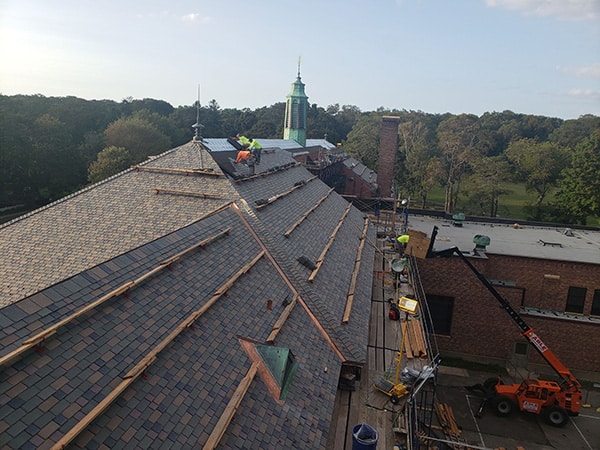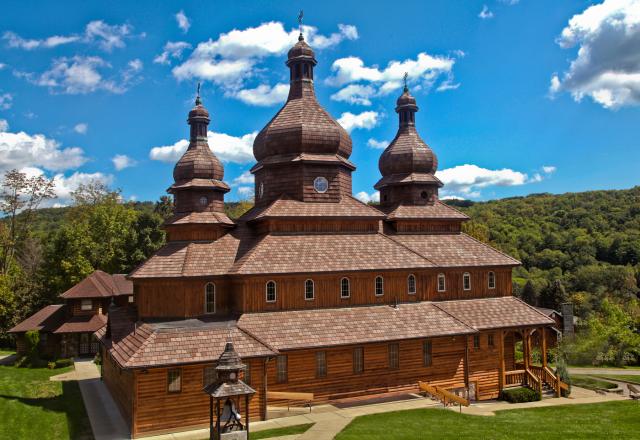Architect Tips for Specifying Composite Roofing Tiles on Historical Projects

Crumbling slate on a 100-year-old school. Hail-pocked cedar shakes on historical churches. Fixing wrongly placed asphalt on an old county courthouse. If you’re in the position of selecting roofing for a historical project, you’re among the growing number of architects discovering that composite roofing tiles are the solution.
When the 1886 red brick administration building in Owantonna, Minnesota, needed a new roof, the city brought in Adsit Architecture and Planning to handle the challenge. Old asphalt shingles needed to be removed. Caretakers of the historical structure, which is on the National Register of Historical Places, wanted to preserve the history of the complex.
“We wanted to bring back the prominence of the original slate roof,” says architect Mark Gunstad with Adsit. “We specifically wanted a composite roof. Our feeling is that it will have a long lifespan. From our search, we determined that DaVinci products provide the most realistic look for a composite roof.
“The European color blend and appearance of the tiles played a major role in the selection. In addition, DaVinci has turret packages available, which was very important. After that, we were looking for a product that’s easy to install. Above all, cost was a factor. DaVinci hits all the marks.
“Our company does a lot of work with historic structures. This is our first time working with the DaVinci product. However, it won’t be our last. We are excited to specify these synthetic roofing tiles on other projects in the future.”
 Lightweight Composite Roofing Tiles
Lightweight Composite Roofing Tiles
While appearance, installation ease and color availability are all good reasons to specify composite roofing tiles for historical projects, there are more. The lightweight nature of the product makes it an attractive asset.
At R.J.O. Intermediate School in Kings Park, New York — home to the Kings Park Heritage Museum — the original slate tile roof on the school had started to crumble in recent years. Worse than that, tiles were sliding off and crashing below, causing the 100-year-old slate roof to become a safety hazard. In addition, the weight of the natural slate also caused areas of the roof to sag.
“All these factors combined, and we knew it was time to replace this roof,” says Superintendent of Schools, Dr. Timothy T. Eagen with Kings Park Central School District in New York. “We wanted to replicate the unique roof. But to complicate this situation, the original building had been extended a few times over the years. Each time a slightly different slate roof pattern and color was used. Now we needed a unified look that mimicked the historic slate.”
The school district turned to H2M architects + engineers out of Melville, New York, for assistance. The team there recommended DaVinci Multi-Width Slate as a replacement historical roofing material.
The lightweight nature of the composite roofing tiles, compared to heavy real slate, helped immediately solve one problem. The product’s Class A fire and Class 4 impact resistance offered other solutions. Above all, the composite roofing tiles resist chipping, cracking and breaking.
Once the product and colors were chosen and approved by the school district, there was one more hurdle. A presentation was made to the State Historic Preservation Office. The review team there was equally impressed with the quality and authenticity of the DaVinci historical roofing material. They gave the composite roofing their immediate approval.
Shaking Up Historical Roofing Material
As popular as synthetic slate is as a historical roofing material, composite shake has also made inroads in many historical projects.
Church buildings previously with real cedar shakes across the country have transitioned to composite cedar shakes. Along with their authentic appearance, the congregations appreciate composite shakes for their fire-resistant, low-maintenance and impact-resistant benefits.
“Because the DaVinci product looked so authentic to real cedar shakes and had a better fire rating than wood shingles, the committee made the decision for the first time ever to allow polymer roofing tiles on a structure in our city.”
- Dave Harter, First Presbyterian Church of Jacksonville Case Study in Oregon – founded in 1881
“We’re both amazed and pleased that these man-made roofing tiles could have such a positive and beautiful impact on our facility. The new polymer shakes look almost identical to the older wooden ones, but these will last so much longer.”
- Teodor B. Czabala, Jr.
 Sacred Heart Ukrainian Catholic Church Case Study in Johnson City, New York – founded in 1977
Sacred Heart Ukrainian Catholic Church Case Study in Johnson City, New York – founded in 1977
“The durability and beauty of this roof really spoke to the church members. The composite roofing answers so many challenges for this project. We were removing old wood shingles, metal and other roofing products. As we tackled the steepness of the steeple, the lightweight nature of the polymer roofing really helped us.”
- Nick Paschke, President of Paschke Brothers Construction
St. John’s Evangelical Lutheran Church Case Study in Kronborg, Nebraska – founded in 1899
For more insights on architects , listen to the podcast “How to Get Composite Roofing Approved on Historical Projects” on RoofersCoffeeShop.com. And, to view other historical roofing material projects, visit “DaVinci Roofing Tops Off Historical Projects.”
